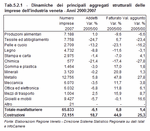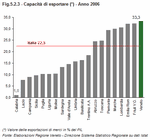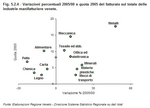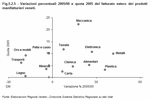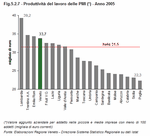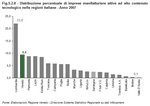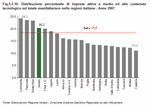|
5.2 - Industrial businesses
The challenge posed by the growing international competition has inevitably had a significant impact on the Veneto businesses in the industrial sector. The need to curb production costs while improving product quality has led to a restructuring of the whole regional manufacturing system: from 2000 to 2005 the number of local businesses in the tertiary sector increased considerably while that of industrial businesses (Note 1) decreased by 20.5% (16,031 businesses). The restructuring of the production sector has also caused a reduction in persons employed of slightly less than 40,000 staff or -6.1%. On the other hand, industrial turnover has grown by 6.8% in the last six years. (Figure 5.2.1), (Figure 5.2.2) and (Table 5.2.1)
In line with the national trend, the regional outlook showed a decrease in production businesses in the main manufacturing sectors with peaks of over 20 percentage points in the food, fashion, i.e. textile and leather, and metal working sectors. Significant decreases in production businesses are also found in the optic and electronic sectors (-11.1%) and in the wood and furniture sectors (about -13%). The reduction of staff has affected production sectors with low technology content. The number of staff decreased in the fashion sector, -24% for textile and -13.2% for leather, and in the wood sector (-8.8%). In the period under consideration, i.e. the years from 2000 to 2005, the added value of Veneto businesses in the production sector increased by 1.4%. In order of importance, growth was mainly due to the metal production sector (+27%), furniture and gold sectors (+16.6%) optic and electronic sectors (+6.1%), means of transport sector, and (+8.7%), mechanical sector (3.8%). The added value has considerably decreased in the textile and clothing sectors (-23.4%), in the leather sector (-16.2%) and in the chemical sector (-27.8%). Between 2000 and 2005 the most dynamic sector of the Veneto economy for the creation of new enterprises and wealth was construction. This sector grew both in terms of new businesses (+25.8%) and of staff (+18.8%). When it comes to turnover the sector also showed significant growth (+44.9%). The international dimension of industrial operations is one of the main factors of economic growth. This is particularly true of a manufacturing area like Veneto, where significant trade relations with other economic areas in the world have been developed for centuries. In 2006 Veneto ranked first among Italian regions for international trade. Its propensity to export, measured by the ratio of export value and regional GDP, is 33.3%. This is not a recent phenomenon as in the Veneto economy exports have been growing at a higher rate than the national average for twenty years, even though in the last few years they have increasingly fallen into line with those of the other regions. (Figure 5.2.3) Several studies - both national and international - show a positive ratio between the openness to foreign markets and a better performance of companies. There is a marked advantage of exporting businesses in terms of size, intensity of physical and human capital and technological level. As to profitability, they exhibit a positive gap and a lower unit cost of labour. In the last few years the weight of export on the total turnover of the Veneto manufacturing sector has tended to grow - from 38.6% in 2000 to 39.3% in 2005. At national level such growth has been about three percentage points - from 34.8% to 38%. The clear growing trend of foreign turnover vs the domestic one is largely due to market internationalisation. In many Veneto manufacturing sectors it makes up about 45% of the total turnover. If the development of the share of foreign turnover on total sales of the main regional goods sectors is analysed, the greater weight of turnover is due to quite different sales patterns. In the leather sector the overall decrease is far more marked in the domestic component of turnover. In the chemical sector the domestic turnover went down while the foreign one increased. In the textile, clothing, optical, electronic and mechanical sectors both types of turnover have increased, but the highest growth levels have been registered for foreign sales. (Figure 5.2.4) and (Figure 5.2.5) In the sectors of gold, furniture and sports products there is a reduction in the share of foreign turnover from 54.2% in 2000 to 44.4% in 2005 as a consequence of a decrease in foreign sales. In the six years under consideration the value of the overall turnover has been virtually stable while the foreign one has reduced by 18%. A reduction in export does not always imply a company's lower capacity to produce wealth. Quite often, the decrease in export concerns companies that have delocalised their production abroad and hence have a trade turnover that often escapes official statistics. Finally, a high increase of both domestic and foreign turnover is reported in the metal working sector. The boom in foreign sales - 41.7% - is however lower than the overall one - 47.8%. This led to a reduction in the weight of the foreign component of turnover from 23.1% in 2000 to 22.1% in 2005. However, it must be recognised that a growth model which is so heavily dependent on export can begin to run into both macroeconomic and manufacturing constraints. In Veneto the increase in foreign turnover is more and more constrained by the difficulty to increase the domestic production capacity through a further use of inputs, especially labour and physical infrastructure. The way forward seems to be the increase of productivity. Labour and plants being equal, only a growth of productivity can ensure continuity in the process of economic development. The objective is to achieve an increase in productivity through strategies of product diversification and a greater role of innovation. (Figure 5.2.6) According to the most recent data available, in 2006 Veneto ranked seventh among regions for labour productivity in narrow industry. The productivity per labour unit of the Veneto industry has been constantly growing since 2003 and in the last year it has almost reached the average national value, approx. 48,000 euros (Note 2). (Figure 5.2.7) Moreover, production in the region is characterised by a high number of small and medium-sized enterprises (SMEs) that are often world leaders in the sectors where a greater tradition and quality are required. SMEs play an important role as an engine for the region's economy and contribute to economic growth as they take over 70% of the added value of the Veneto industry. An analysis of data concerning productivity - at current prices and available up to 2005 - per unit of staff in SMEs shows that the average regional value of about 34,000 euros exceeds the national one by approx. 2,000 euros. Veneto ranks fourth among regions - behind Lombardia, Trentino Alto Adige and Emilia Romagna. In the last few years, as was the case with the other main Italian regions, the productivity per unit of staff has started rising again and has matched the record values of 2002.
Science and technology have enormous potential for the creation of wealth in a region, but they also contribute to improve the citizens' quality of life. Especially high-tech products are meant to improve the welfare of their users.
In 2007 Veneto enterprises with high technological content accounted for 9.4% of the nation-wide high-tech enterprises, according to the OECD classification (2003) (Note 3). (Figure 5.2.8) and (Figure 5.2.9) Low-tech manufacturing is still prevailing as it makes up over half of the whole industry. It consists of the traditional "Italian-made" sectors - clothing, furniture, food and agriculture. These traditionally very labour-intensive sectors have been exposed to the competition of countries where the cost of labour is 20 or even 50 times lower, but can still exploit technology that escapes OECD classification. The textile and clothing sectors are betting on quality - better quality products, innovative output both from the strictly technical point of view of cloth performance and from the point of view of intangible aspects such as image and fashion. The production of sportswear attempts to enhance comfort besides lifestyle. Furniture and gold production rely on design, use of new materials or unusual mixing of modernised old items. The food and agriculture sectors are changing as they are reverting to craft and organic products or products that stand out for their certificate of origin. Overall, if the Veneto is compared with Italy as to the distribution of enterprises across technology levels, high-technology and medium-high-technology enterprises together make up 20.3% of the whole manufacturing sector. This percentage is over the national one of 18.5%. (Figure 5.2.10) More specifically, the high-tech sector mainly includes enterprises belonging to the medical, precision and optical appliances sectors which make up 80% of total high-tech enterprises in Veneto and accounts for 9.4% of the whole national sector, followed by radio and TV appliances (12%). The index of sector specialisation shows a greater regional focus on optical instruments, medical appliances and precision tools compared to Italy. Moreover, from 2000 to 2007 the share of low and medium-low technology enterprises decreased slightly while the share of medium technology enterprises rose. (Figure 5.2.11)
To compete on increasingly globalised international markets entrepreneurs have to choose between a production model based on low prices and little added value - also achieved by outsourcing production to low-income countries - or increasing quality in order to secure increasing market shares with this added value.
An analysis of export data concerning manufacturing goods by technology level (Note 4) suggests that the competitiveness of Veneto goods is more and more based on quality. This tendency is observed not only for high-technology goods but also extends to all sectors and all types of goods. There are peaks of excellence in medium-high-technology productions as in low-tech ones where design and brand are the factors behind success on the international markets. Contrary to what happens at national level, it can be observed that Veneto exports of low-tech products in the period under observation experienced a net reduction from 43% in 2000 to 36.2% in 2007. Low-tech productions are strongly affected by foreign competition but, especially in the food and clothing sectors, there are some areas having extended their market share. This would appear to confirm the repositioning of many enterprises - even small and medium-sized ones - in sectors with higher added value and high specialisation. (Figure 5.2.12) Medium technology productions which in 2007 made up more than 55% of Veneto exports have considerably increased compared to 2000 - about 8 percentage points. In the period under examination the weight of exports of medium-tech products in all leading sectors - chemistry, mechanics and metal working - increased and for this sector too a repositioning of regional operators in the higher segments of the market. In 2007 8.4% of the region's exports concerned goods classification of high-tech production. This percentage has been subject to some fluctuation in the last few years. The share of Veneto exports saw a positive trend until 2002 as it exceeded 10% and then decreased until 2006, again going up slightly in 2007. On the one hand the relevance of exports of medical and optical appliances, the top high-tech Veneto sector with exports over 2.6 m euros, and office furniture is going up, whereas on the other pharmaceutical products and aerospace vehicles are losing importance.
|
|
Data elaborated by the Statistics office of the Veneto region are collective property; reproduction of this material is authorised for non-commercial purposes only, provided the source "Regione Veneto - Regional Statistics System Management" is acknowledged.


 Index
Index  Home
Home 

